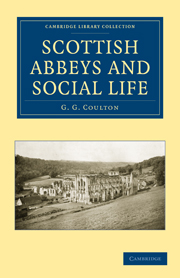Book contents
- Frontmatter
- Contents
- LIST OF ILLUSTRATIONS
- Preface
- Chapter I Celtic Monachism
- Chapter II The Monastic Rules
- Chapter III Monastic Revenues
- Chapter IV How Endowments Came (I)
- Chapter V How Endowments Came (II)
- Chapter VI Monks and Parishes (I)
- Chapter VII Monks and Parishes (II)
- Chapter VIII Charity (I)
- Chapter IX Charity (II)
- Chapter X Monk and Peasant (I)
- Chapter XI Monk and Peasant (II)
- Chapter XII Monastic Housekeeping
- Chapter XIII Church and Scriptorium
- Chapter XIV The Monastic Chronicler
- Chapter XV Schools
- Chapter XVI Art and Learning
- Chapter XVII Professions and Business
- Chapter XVIII Visitation (I)
- Chapter XIX Visitation (II)
- Chapter XX A Voice from the Cloister
- Chapter XXI Conclusion
- Appendixes
- List of Authorities
- Index
Chapter XVII - Professions and Business
Published online by Cambridge University Press: 05 August 2011
- Frontmatter
- Contents
- LIST OF ILLUSTRATIONS
- Preface
- Chapter I Celtic Monachism
- Chapter II The Monastic Rules
- Chapter III Monastic Revenues
- Chapter IV How Endowments Came (I)
- Chapter V How Endowments Came (II)
- Chapter VI Monks and Parishes (I)
- Chapter VII Monks and Parishes (II)
- Chapter VIII Charity (I)
- Chapter IX Charity (II)
- Chapter X Monk and Peasant (I)
- Chapter XI Monk and Peasant (II)
- Chapter XII Monastic Housekeeping
- Chapter XIII Church and Scriptorium
- Chapter XIV The Monastic Chronicler
- Chapter XV Schools
- Chapter XVI Art and Learning
- Chapter XVII Professions and Business
- Chapter XVIII Visitation (I)
- Chapter XIX Visitation (II)
- Chapter XX A Voice from the Cloister
- Chapter XXI Conclusion
- Appendixes
- List of Authorities
- Index
Summary
On the question of monastic services to medicine, sentimental and undocumented history has wandered farther from the truth, perhaps, than at any other point. Father Barrett is only exaggerating a little upon many predecessors, from Montalembert onwards, when he sums up monastic services to society (pp. 209 ff.). He writes:“Like other branches of knowledge, that of medicine was monopolized by monks in what may be termed the monastic age of Scotland. They were the recognized physicians of their time; and to them the poor turned for help and medicine in time of sickness”. The fact is, that popes and disciplinarians seldom or never mention monastic medicine except to forbid or discourage it, and this for two plain reasons; that it took them away from their true vocation, and that it tempted them to enrich themselves with fees. St Benedict's Rule has no hint of medicine except for the sick monks; and, even there, strict disciplinarians like St Bernard deprecated anything more than simple herbs and common-sense treatment. Later, when monastic ambition and the temptation of money caused serious difficulties, the popes stepped in. Alexander III (1159-85) writes:
The devil, after his accustomed fashion, transfiguring himself into an angel of light, under colour of caring for the bodies of sick brethren and of administering ecclesiastical business for the faithful, entices certain monks from their cloisters in order to study law and to weigh out medicinal prescriptions. […]
- Type
- Chapter
- Information
- Scottish Abbeys and Social Life , pp. 203 - 213Publisher: Cambridge University PressPrint publication year: 2010First published in: 1933

